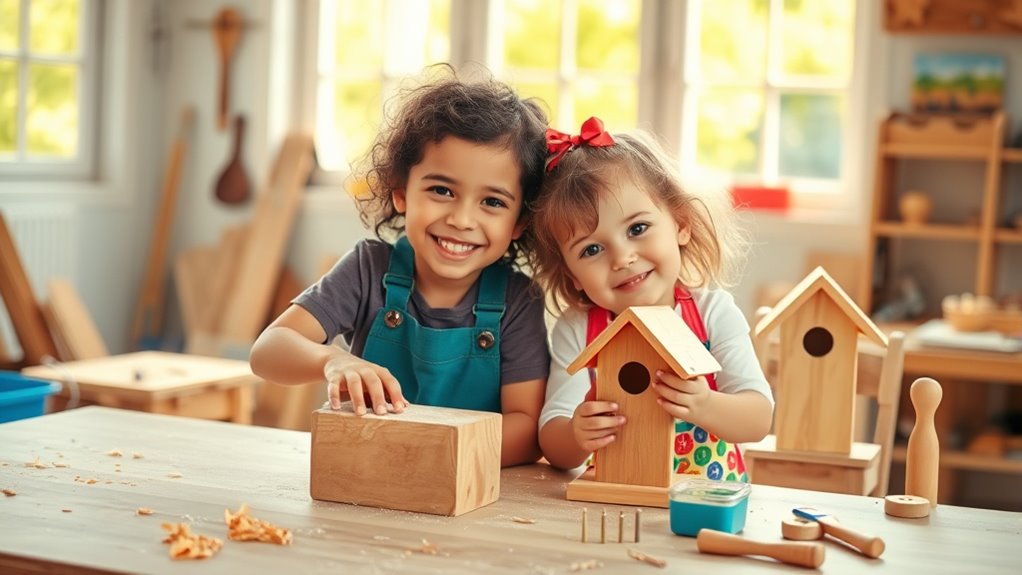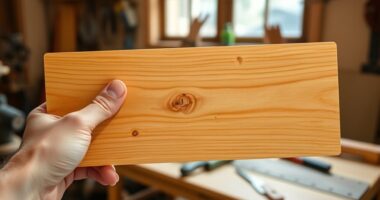Creating simple wood projects with kids is a fantastic way to boost their motor skills, encourage creativity, and foster confidence. These activities involve basic tools and steps, helping children develop hand-eye coordination and practical life skills safely. As they plan, problem-solve, and finish projects, they learn teamwork, patience, and responsibility. Keep exploring, and you’ll find plenty of easy, engaging ideas to inspire your child’s imagination and growth through crafting together.
Key Takeaways
- Simple wood projects boost motor skills and hand-eye coordination through cutting, gluing, and assembling activities.
- They foster creativity and imagination by allowing kids to personalize and design their own crafts.
- Crafting with wood develops planning, sequencing, and problem-solving abilities in a fun, hands-on way.
- These projects promote teamwork, sharing, and social skills during collaborative building experiences.
- They teach safe tool use and patience, encouraging independence and responsible craftsmanship.

Crafting with kids is a wonderful way to support their overall development while having fun together. When you engage in simple wood projects, you’re not just creating something special—you’re helping your child develop essential skills that will benefit them throughout life.
Wood crafts are excellent for refining fine motor skills, as they involve precise movements like cutting, sanding, gluing, and assembling. Using tools and manipulating wooden pieces helps improve hand-eye coordination and strengthens the small muscles in their hands and fingers. These skills are fundamental for everyday activities, such as eating, dressing, and tying shoelaces, so the more they practice, the more confident they become in their independence.
In addition to motor development, working with wood sparks your child’s creativity and imagination. When they explore different textures, shapes, and sizes of wooden pieces, they learn to think outside the box. Crafting allows them to see the world from their own unique perspective and express their feelings through art.
Building a birdhouse, a picture frame, or a small box encourages open-ended creativity and problem-solving. They get to experiment with different arrangements, which helps develop their critical thinking and decision-making skills. Plus, these projects can be tailored to their interests, making the activity more engaging and meaningful.
Crafting with wood also boosts cognitive and organizational skills. Following instructions to assemble a project teaches children how to plan and sequence steps carefully. As they gather materials and decide how to combine them, they practice organizing and managing tasks. Engaging in these projects can also introduce children to STEM concepts, fostering early interest in science and engineering fields.
When something doesn’t go as planned, they learn to troubleshoot and adapt, strengthening their problem-solving abilities. The process of completing a project from start to finish helps them understand cause and effect, especially when they see how their adjustments influence the final product.
Beyond the cognitive benefits, woodworking projects foster emotional and social growth. Finishing a project gives children a sense of accomplishment, boosting their self-esteem. Working together on a craft encourages sharing ideas, taking turns, and cooperating, which enhances social skills and teamwork.
The tactile nature of wood crafts can also be calming, helping children relax and focus, reducing stress. Additionally, these activities provide a wonderful opportunity for children to express their feelings through their creations, supporting emotional development and self-awareness.
Engaging in simple wood projects with your kids builds practical life skills, such as using tools safely and responsibly. Research shows that incorporating hands-on activities like woodworking can also introduce children to STEM concepts, laying a foundation for future learning and interest in science and engineering. Completing projects teaches responsibility, patience, and persistence, while also inspiring curiosity about STEM fields.
As they develop these skills, they become more independent in both personal and academic contexts. Overall, crafting with wood is a meaningful way to nurture your child’s growth, creativity, and confidence—all while having fun together.
Conclusion
Now that you’ve explored these simple wood projects, imagine the possibilities waiting just around the corner. Each piece you create with your kids isn’t just a craft—it’s a memory, a lesson, a secret waiting to be uncovered. The best part? This is only the beginning. As you and your little ones continue to build and learn together, you’ll discover that the true magic lies not in the finished projects, but in the journey you share.









